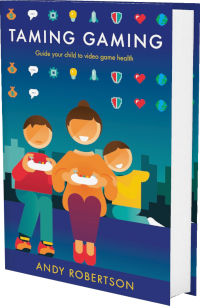 Android
Android iOS
iOS Mac
Mac Switch
Switch Wii
Wii Wii U
Wii U PC
PC PS4
PS4 PS5
PS5 Xbox One
Xbox One Xbox X|S
Xbox X|SThe Taming Gaming book and this Family Video Game Database are designed to complement each other. The database is searchable and updated every day, while the book is a longer, slower look at the detail of video games and children's health. Together they aim equip you with confidence and literacy to take action in this area of your child's life so they can get the most from it and you can enjoy it as well.
Thankfully, there’s no single vision of game play, and no idealised model of family life, on offer in this book. Instead, Taming Gaming works to establish a new norm: that we can maximise the opportunities and minimise the risks by diversifying our understanding of video games.
- Sonia Livingstone OBE, LSE Professor
- Sonia Livingstone OBE, LSE Professor
The book was funded thanks to the hundreds of parents, carers and guardians who enthusiastically supported it, along with a range of video game regulators, academics, developers and platform-holders, not-for-profit organisations and many schools. In their financial support, this broad coalition enabled me to spend the time I needed to gather, sift and present this crucial information that parents need. The views expressed are my own and do not represent any particular supporter.
A Book About Video Games For Parents
Taming Gaming is an unflinching look at the impact of gaming on family life by journalist and parent Andy Robertson, drawn from years of covering this topic for newspapers, radio and TV. It compiles the latest research and advice from psychologists, industry experts, parents, schools and children’s charities.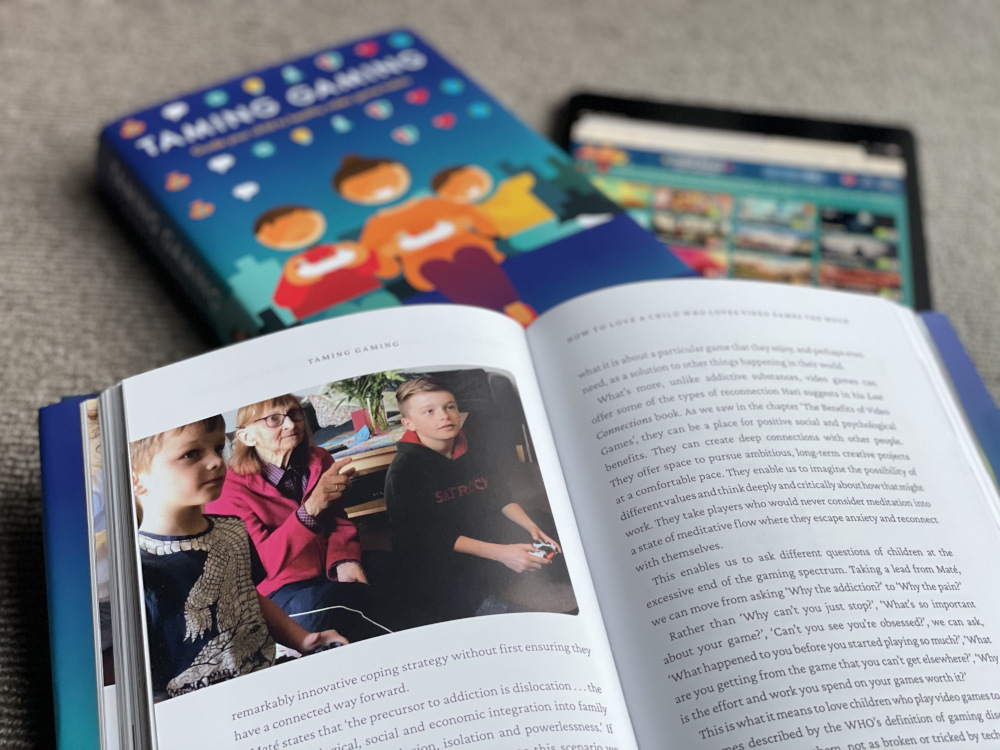
Discover what really happens when a child plays a video game. Face fears about screen time and start steering your child’s gaming from violence, expense and addiction towards fulfilling, connecting, affordable experiences.
You don’t need to be a gamer, or want to play games but to guide your child to gaming health you need to understand the actual benefits and dangers of gaming rather than the worrying headlines and reactionary news.
The second half of the book (and this online game advice library) offers simple to follow, tried and tested Family Gaming Recipes. They are a super-easy way to discover games that are beneficial rather than stressful for your family.
Each beautifully laid out recipe tells you everything you need to know with jargon-free instructions that take the guesswork out of gaming together. Accessing this broad diet of cutting edge games your children will love, enables you to help them navigate this unavoidable part of life.
Taming Gaming sets the bar high for your child’s video game health, with insights from the latest video game research. It helps you tame the games your child plays, by equipping you to make informed decisions, engage in this area of life and guide their gaming diet.
Foreword - Sonia Livingstone OBE, LSE Professor
I recently overheard a lively conversation about playing the online video game Diabolo – which characters did you choose, what level have you reached, did your chosen tactics work out? You might think I was listening to a couple of children but in fact it was my 60-something partner and our 30-something son. They have been having this conversation now for a couple of decades, and it is deeply embedded in their relationship.
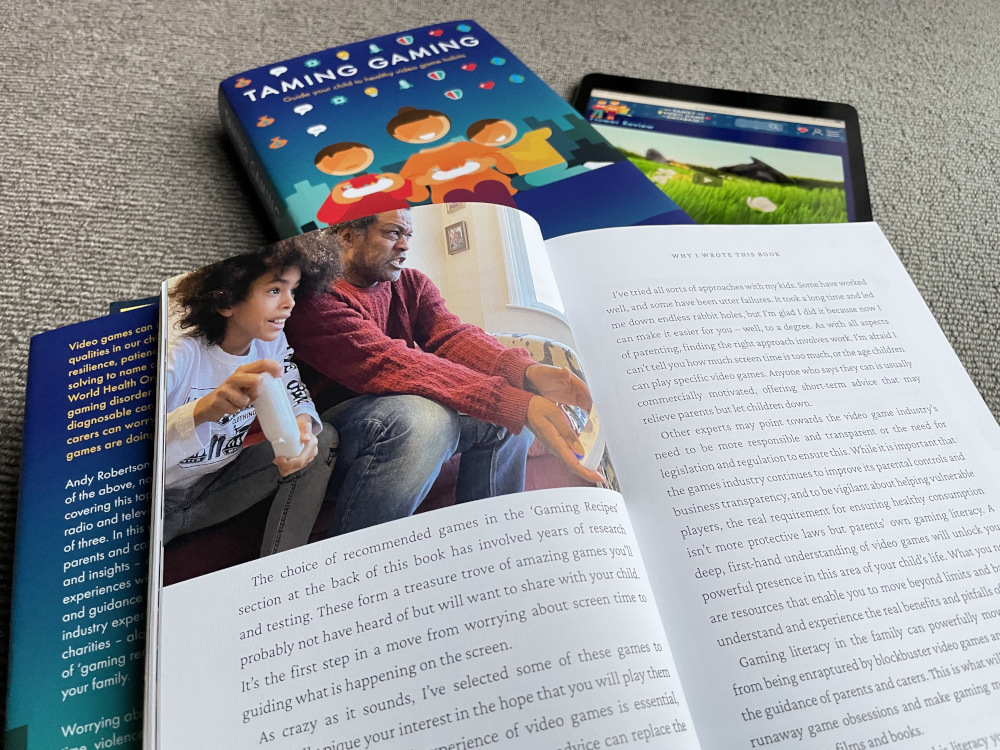 Parent-child conversations are often unequal in knowledge and power, but talk about video games allows a way of relating to each other that is egalitarian, as well as committed, lively and thoughtful. Tactics can be developed collaboratively, experiences become mutual, and a part of children’s lives that is often closed to parents can instead be recognised and valued.
Parent-child conversations are often unequal in knowledge and power, but talk about video games allows a way of relating to each other that is egalitarian, as well as committed, lively and thoughtful. Tactics can be developed collaboratively, experiences become mutual, and a part of children’s lives that is often closed to parents can instead be recognised and valued.Insights such as these underpin Taming Gaming. The book is sympathetic to parents’ struggles and worries, informed about the gaming world, and strongly committed to understanding and benefiting children’s lives. While it was written before COVID-19, present circumstances make the book more relevant than ever. Children’s screen time has surged, because their reliance on all things digital is no longer a matter of choice but one of necessity. Guidance for parents on enabling the benefits and avoiding the harms is, in consequence, more vital than ever.
Fifteen years of writing about video games, listening to children and working with families as they play games and argue about them, has given Andy Robertson a wealth of experience and expertise to pour into this book. He shows convincingly how video games, like other kinds of games children play, offer fun, first and foremost, as well as opportunities to be creative, to learn, to share and collaborate with others, to face challenges, solve problems and extend their imagination and understanding, to make mistakes and recover themselves, gaining resilience, digital expertise and confidence. Video games are not only an online experience but also contribute offline - to sibling relations, relations among friends, and if you let them, a positive relationship between parent and child.
I wish I had known all this when my son was young. Echoing the book’s introduction, I too remember wanting to shut the video games in a locked cupboard, even once in anger hiding the extension cord into which the computer and, it seemed, my son, was constantly plugged. I suspect many parents need encouragement to give up on the dominant (and dominating) language of controlling, even policing the technology and, by implication, our children too.
Taming Gaming invites us instead to think in terms of actively engaging with video games in ways that are informed by evidence, balanced according to practical circumstances, and respectful of family values and children’s interests. The approach is optimistic, but not naively so. The purpose is to guide parents and children living in a now-inescapably digital world, while not becoming overwhelmed by digital challenges, or forgetting about the rest of life.
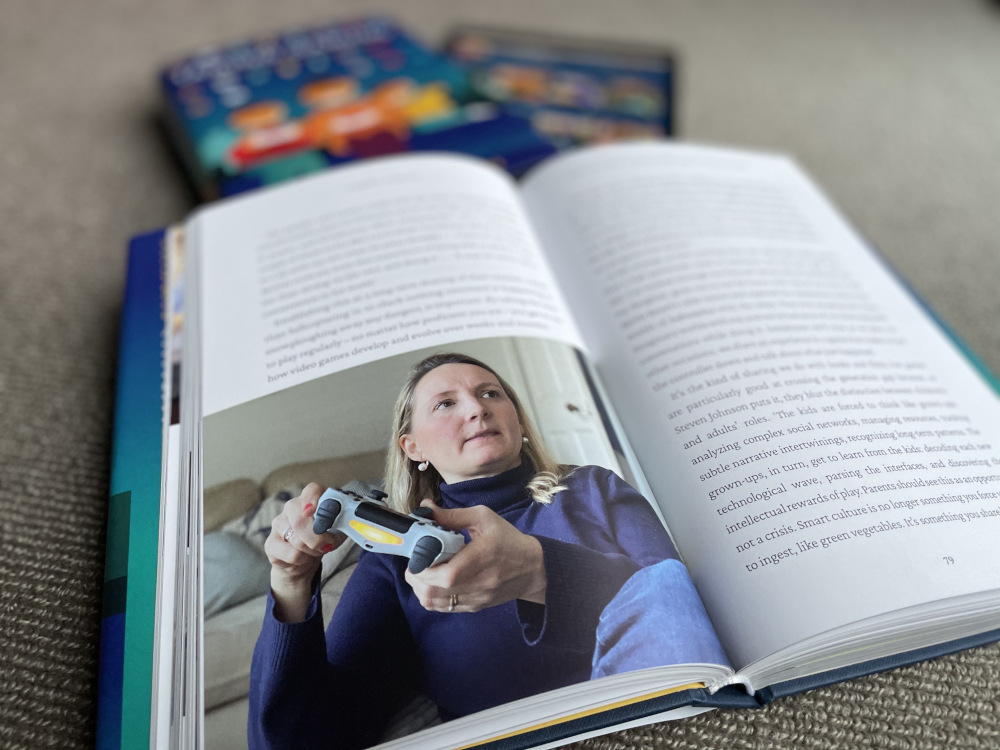 Of course there are the downsides – excessive video game time, violent and other problematic contents, bullying and hostile peer exchanges, commercial exploitation and more. Taming Gaming attends to these with care, and points to a wealth of resources to help parents navigate the landscape of video games so as to find what is best and avoid the difficulties. While I believe it is vital for regulators and industry to take effective action to ensure that children are both empowered and safe online, I agree with Andy Robertson’s premise that parents are a crucial influence on their children’s lives, including the digital. So a book that can inspire parents to join in themselves, and to develop their own gaming literacy is very welcome.
Of course there are the downsides – excessive video game time, violent and other problematic contents, bullying and hostile peer exchanges, commercial exploitation and more. Taming Gaming attends to these with care, and points to a wealth of resources to help parents navigate the landscape of video games so as to find what is best and avoid the difficulties. While I believe it is vital for regulators and industry to take effective action to ensure that children are both empowered and safe online, I agree with Andy Robertson’s premise that parents are a crucial influence on their children’s lives, including the digital. So a book that can inspire parents to join in themselves, and to develop their own gaming literacy is very welcome. It’s time to stop panicking about technology and start prioritising what we can do with it. So much of the creative and collaborative potential of technology is under-used: we must imagine better for our children, recognising their diversity and their potential, and I love how this book guides parents step by step in doing just this, with practical tips and gaming suggestions.
Thankfully, there’s no single vision of game play, and no idealised model of family life, on offer in this book, nor any ‘right answer’ thinking. Instead, Taming Gaming works to establish a new norm: that we can maximise the opportunities and minimise the risks by diversifying our understanding of video games and then making thoughtful judgements about the available options, instead of everyone opting for the same few games that everyone else plays. Families are hugely different in their interests, values and circumstances, and this can become a strength if we let it.
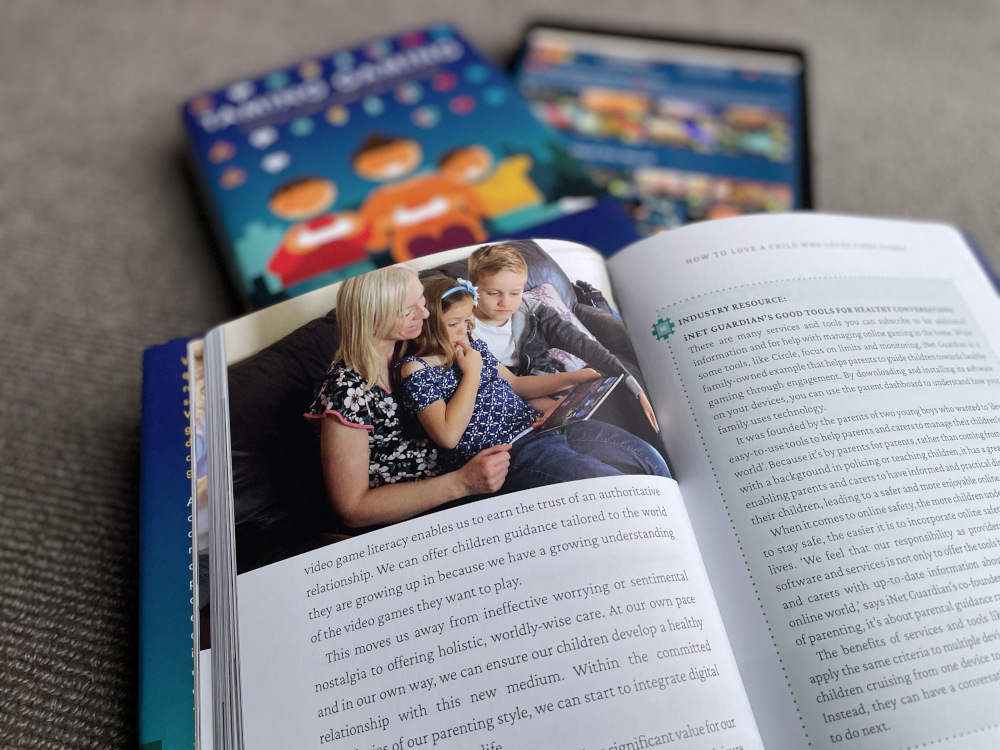 Many parents will like to try out the plethora of “gaming recipe suggestions” in this book. And for those who want to follow up on the wealth of research and evidence that Taming Gaming draws upon, without ever getting bogged down in detail, the footnotes are there. I particularly appreciate the light-touch yet nuanced treatment of so-called “gaming addiction,” since this remains highly controversial to both researchers and clinical practitioners. Contrary to popular media headlines, problems of excessive use are likely to apply only to a tiny minority of children. But as I found in my own research with families, terminology contested among experts - such as addiction or screen time – are finding their way into our everyday discourse, becoming a problem in their own right by provoking family conflict, adding to parental guilt and worrying children too.
Many parents will like to try out the plethora of “gaming recipe suggestions” in this book. And for those who want to follow up on the wealth of research and evidence that Taming Gaming draws upon, without ever getting bogged down in detail, the footnotes are there. I particularly appreciate the light-touch yet nuanced treatment of so-called “gaming addiction,” since this remains highly controversial to both researchers and clinical practitioners. Contrary to popular media headlines, problems of excessive use are likely to apply only to a tiny minority of children. But as I found in my own research with families, terminology contested among experts - such as addiction or screen time – are finding their way into our everyday discourse, becoming a problem in their own right by provoking family conflict, adding to parental guilt and worrying children too.I agree with Taming Gaming’s recommendations to parents – learn more, join in, and replace inchoate anxieties with informed choices. We don’t know what the future holds. Digitally-mediated outcomes for children remain unknown and may prove riskier than more traditional routes to learning and sociability. Evidence for benefits and harms continues to accumulate and must be sifted, weighed and critically discussed. In the meantime, parents have to parent. Doing so with this book in hand can only be empowering, so dive in, have fun, and keep your eyes not on the “screen time” clock but on what’s good for your child.
Sonia Livingstone OBE, LSE Professor and author of Parenting for a Digital Future
Chapter 1 - Why I Wrote This Book
Video games promised to transport my children to magical lands, to seed their imaginations, inspire their creativity, let them compete on a world stage and tell them stories full of hope and laughter. The reality, however, was not like this. There were arguments about when to stop, family rooms full of plastic peripherals and constant pestering for the next new game before they’d done enough washing up to earn the last one.I wanted to close the door and leave them to it. But that would admit that the games had won. I wanted to lock them in a high cupboard – the games, I mean, not the children. Besides, I was a games journalist, damn it!
For reasons I can’t fully remember, I didn’t get rid of the games and I didn’t leave them to it. It was my job to write about these things; that was certainly part of it. I was suspicious that the technology would take over, but I didn’t want to miss out on this part of their playtime, even if their games seemed juvenile, brash and boring.
A decade later, I’m glad I didn’t back away.
Time spent playing games with them has been as important as eating together, going for woodland walks, making dens in the garden and trips to the cinema and the beach. They didn’t need my help to play the games – quite the reverse in fact – but they did need me to model a healthy relationship with them. Not just stopping well, prioritising face-to-face communication or finding a wide range of experiences to enjoy but integrating video games with the rest of our family life.
Children are expert players of video games. Digital interactive spaces are among their native habitats. They swipe to unlock before they can write and tap, drag and scroll before they can read. They are highly literate in the language of interaction. They are instinctively drawn to video games as experiences made for them; the medium of their time.
But beyond this veneer of confidence, they are as ill-equipped to cope with these commercial, endless and powerfully connected experiences on their own as they are to handle supermarket shopping, being ill, watching adverts for toys, not eating too many sweets, football crowds, crossing roads safely, failing at tests, or the death of a grandparent.
As with these other things, children need parents and carers to show them how to navigate video games. They need advice on how to cope with losing. They need guidance on how to walk away before they throw the controller. They need grown-ups to anchor these important experiences as one part of their wider life. They need parents to integrate digital play with the real world rather than push it away as a separate, lesser alternative. They need adults to suggest more interesting or ambitious games they haven’t heard of.
My children haven’t come to me and asked for any of this. They bleat about games: ‘Just one more go’, ‘It’s not fair’, ‘There’s nothing else to do’, ‘He’s cheating’, ‘I’ve wasted my day’ and ‘Why can’t I? Everyone else is playing it.’ What they’re actually asking is how to keep video games enjoyable. How to avoid getting controlled by them. How to relate their virtual worlds to the rest of life. Or maybe, even, how to avoid their gaming time increasing despite negative consequences.
Without support and guidance, gaming can become worrying territory for parents. In the extreme, we see what the World Health Organization (WHO) designates as ‘gaming disorder’. This recent addition to its disease classification only applies to a tiny proportion of children unable to stop gaming gluttony even when faced with serious and severe negative consequences, but it’s still a concerning cliff edge when your child won’t stop for tea time.
Despite school-gate hand-wringing over our kids’ addiction to the latest game, our tone is telling. We don’t mean this in the way described by WHO. As history shows us, with any new media – comics, radio, television and even the telephone – we are predisposed to panicking that new technology will create obsessive, delinquent or violent behaviour.
By exploring the reality of the issues and science behind scary headlines – as we’ll do in the following pages – I realised that the solution isn’t complicated or expensive but just traditional parenting. Rather than helicoptering in when things go wrong, or snowploughing away any challenges, we need to be present and guide our children’s gaming with both involvement and boundaries, as we do in the rest of their childhood. Children who play games need parenting rather than policing.
But how? Where do you start? Video games seem different and alien compared to the traditional rites of childhood: learning to read, eating vegetables, going to school, playground hierarchy, trips to the zoo and days out to the beach.
Here’s the good news. The answer isn’t easy, but it is simple: to raise grounded children who love playing video games, you need to play video games yourself. Sounds crazy, doesn’t it? Who does that? Well, with some help and guidance, you can.
If you don’t play games and don’t want to, if you find your child’s gaming worrying or frustrating, if you’d rather leave your children to it or just throw all the games away, then this book is for you. Without jargon or unrealistic suggestions, I’ll explain what experts say really happens when your child plays a video game and offer simple advice for you to care for them in this crucial area of their lives. It’s a positive picture of what games are, but one that also grasps the dangers we worry about: addiction, gambling, violence, strangers and unexpected costs.
The advice includes powerful tools to get breathing space from gaming when things have got out of hand and how to seek professional assistance in extreme cases, but it culminates with lots of ways to guide and engage with your child’s gaming as a healthy part of family life.
The choice of recommended games in the ‘Gaming Recipes’ section at the back of this book has involved years of research and testing. These form a treasure trove of amazing games you’ll probably not have heard of but will want to share with your child. It’s the first step in a move from worrying about screen time to guiding what is happening on the screen.
As crazy as it sounds, I’ve selected some of these games to specifically pique your interest in the hope that you will play them yourself. This first-hand experience of video games is essential, in the same way that no amount of expert advice can replace the flavour, texture, smell and taste of wine in the mouth.
Despite school-gate hand-wringing over our kids’ addiction to the latest game, our tone is telling. We don’t mean this in the way described by WHO. As history shows us, with any new media – comics, radio, television and even the telephone – we are predisposed to panicking that new technology will create obsessive, delinquent or violent behaviour.
By exploring the reality of the issues and science behind scary headlines – as we’ll do in the following pages – I realised that the solution isn’t complicated or expensive but just traditional parenting. Rather than helicoptering in when things go wrong, or snowploughing away any challenges, we need to be present and guide our children’s gaming with both involvement and boundaries, as we do in the rest of their childhood. Children who play games need parenting rather than policing.
But how? Where do you start? Video games seem different and alien compared to the traditional rites of childhood: learning to read, eating vegetables, going to school, playground hierarchy, trips to the zoo and days out to the beach.
Here’s the good news. The answer isn’t easy, but it is simple: to raise grounded children who love playing video games, you need to play video games yourself. Sounds crazy, doesn’t it? Who does that? Well, with some help and guidance, you can.
If you don’t play games and don’t want to, if you find your child’s gaming worrying or frustrating, if you’d rather leave your children to it or just throw all the games away, then this book is for you. Without jargon or unrealistic suggestions, I’ll explain what experts say really happens when your child plays a video game and offer simple advice for you to care for them in this crucial area of their lives. It’s a positive picture of what games are, but one that also grasps the dangers we worry about: addiction, gambling, violence, strangers and unexpected costs.
The advice includes powerful tools to get breathing space from gaming when things have got out of hand and how to seek professional assistance in extreme cases, but it culminates with lots of ways to guide and engage with your child’s gaming as a healthy part of family life.
The choice of recommended games in the ‘Gaming Recipes’ section at the back of this book has involved years of research and testing. These form a treasure trove of amazing games you’ll probably not have heard of but will want to share with your child. It’s the first step in a move from worrying about screen time to guiding what is happening on the screen.
As crazy as it sounds, I’ve selected some of these games to specifically pique your interest in the hope that you will play them yourself. This first-hand experience of video games is essential, in the same way that no amount of expert advice can replace the flavour, texture, smell and taste of wine in the mouth.
This book provides the guidance I wish I’d had when embarking on this journey with my children. I figured it out the hard way, through trial and error, trawling the Internet, talking to developers, reading books and academic papers on the subject, and interviewing game-rating agencies.
I’ve tried all sorts of approaches with my kids. Some have worked well, and some have been utter failures. It took a long time and led me down endless rabbit holes, but I’m glad I did it because now I can make it easier for you – well, to a degree. As with all aspects of parenting, finding the right approach involves work. I’m afraid I can’t tell you how much screen time is too much, or the age children can play specific video games. Anyone who says they can is usually commercially motivated, offering short-term advice that may relieve parents but let children down.
Other experts may point towards the video game industry’s need to be more responsible and transparent or for the need for legislation and regulation to ensure this. While it is important that the games industry continues to improve its parental controls and business transparency, and to be vigilant about helping vulnerable players, the real requirement for ensuring healthy consumption isn’t more protective laws but parents’ own gaming literacy. A deep, first-hand understanding of video games will unlock your powerful presence in this area of your child’s life. What you need are resources that enable you to move beyond limits and bans to understand and experience the real benefits and pitfalls of games.
Gaming literacy in the family can powerfully move children from being enraptured by blockbuster video games and back under the guidance of parents and carers. This is what will curb potential runaway game obsessions and make gaming more like its media stablemates, films and books.
Best of all, by developing this literacy you get to share the fun with your child as you play together. You can enjoy games with them, guiding their passion and discovering a deeply useful context in which to prepare them to thrive in their digital future.
If all this isn’t news to you, then skip on to the Gaming Recipes at the back of the book for hundreds of new games to play with your children. If you’re less convinced, or even a little suspicious, the following chapters will expand on this perspective. They cover ideas I’ve tried with hundreds of families. Mums who didn’t want video games taking over. Dads concerned about the effect of watching violence. Carers worried about a potential addiction. It’s been a privilege to help equip them to do what they do best in this area of childhood: to parent and care for children.
Some cases stand out. There’s the mother who was worried about losing her son, Harry, to video games. After talking, I suggested she try playing one of the games in the back of this book, That Dragon Cancer. The next morning I woke up to this email:
I played it last night. Hadn’t realised how long it would be so had to pause it as it was getting on for 1 a.m.! What a very unfamiliar feeling to be playing a video game into the night! Beautiful animation and graphics. I loved the music and of course, the story – very poignant.
It’s opened up all kinds of possibilities in my mind with Harry, which feels good. I slipped it into the conversation this morning and his whole demeanour shifted. I really have felt like he was disappearing in front of me with the video game issue as the driver, but I absolutely feel that this is the way to go.
Stories like this are why I wrote this book: to empower parents and carers with video game literacy and with the confidence to guide their children in this new, inevitable and normal part of childhood.
I’ve tried all sorts of approaches with my kids. Some have worked well, and some have been utter failures. It took a long time and led me down endless rabbit holes, but I’m glad I did it because now I can make it easier for you – well, to a degree. As with all aspects of parenting, finding the right approach involves work. I’m afraid I can’t tell you how much screen time is too much, or the age children can play specific video games. Anyone who says they can is usually commercially motivated, offering short-term advice that may relieve parents but let children down.
Other experts may point towards the video game industry’s need to be more responsible and transparent or for the need for legislation and regulation to ensure this. While it is important that the games industry continues to improve its parental controls and business transparency, and to be vigilant about helping vulnerable players, the real requirement for ensuring healthy consumption isn’t more protective laws but parents’ own gaming literacy. A deep, first-hand understanding of video games will unlock your powerful presence in this area of your child’s life. What you need are resources that enable you to move beyond limits and bans to understand and experience the real benefits and pitfalls of games.
Gaming literacy in the family can powerfully move children from being enraptured by blockbuster video games and back under the guidance of parents and carers. This is what will curb potential runaway game obsessions and make gaming more like its media stablemates, films and books.
Best of all, by developing this literacy you get to share the fun with your child as you play together. You can enjoy games with them, guiding their passion and discovering a deeply useful context in which to prepare them to thrive in their digital future.
If all this isn’t news to you, then skip on to the Gaming Recipes at the back of the book for hundreds of new games to play with your children. If you’re less convinced, or even a little suspicious, the following chapters will expand on this perspective. They cover ideas I’ve tried with hundreds of families. Mums who didn’t want video games taking over. Dads concerned about the effect of watching violence. Carers worried about a potential addiction. It’s been a privilege to help equip them to do what they do best in this area of childhood: to parent and care for children.
Some cases stand out. There’s the mother who was worried about losing her son, Harry, to video games. After talking, I suggested she try playing one of the games in the back of this book, That Dragon Cancer. The next morning I woke up to this email:
I played it last night. Hadn’t realised how long it would be so had to pause it as it was getting on for 1 a.m.! What a very unfamiliar feeling to be playing a video game into the night! Beautiful animation and graphics. I loved the music and of course, the story – very poignant.
It’s opened up all kinds of possibilities in my mind with Harry, which feels good. I slipped it into the conversation this morning and his whole demeanour shifted. I really have felt like he was disappearing in front of me with the video game issue as the driver, but I absolutely feel that this is the way to go.
Stories like this are why I wrote this book: to empower parents and carers with video game literacy and with the confidence to guide their children in this new, inevitable and normal part of childhood.
 | Andy Robertson |
© 2024 Family Gaming Database


